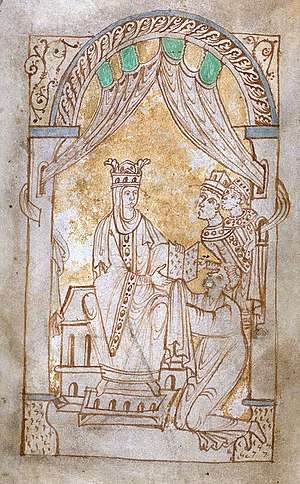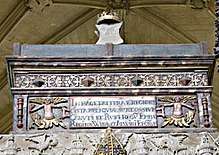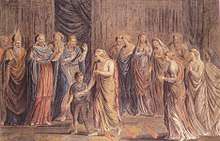Emma of Normandy
Emma of Normandy (Referred to as Ælfgifu in royal documents[2]; c. 984 – 6 March 1052) was queen of England, Denmark and Norway through her marriages to Æthelred the Unready (1002–1016) and Cnut the Great (1017–1035). She was the daughter of Duke Richard I of Normandy and Gunnor. After her husbands' deaths Emma remained in the public eye, and continued to participate actively in politics during the reigns of her sons by each husband, Edward the Confessor and Harthacnut. She is the central figure within the Encomium Emmae Reginae, a critical source for the history of early 11th-century English politics. As Catherine Karkov notes, Emma is one of the most visually represented early medieval queens.[3]
| Emma of Normandy | |
|---|---|
 Emma receiving the Encomium, in The Encomium of Queen Emma, c. 1050, British Library MS 33241. | |
| Queen consort of England | |
| Tenure | 1002 – summer 1013 3 February 1014 – 23 April 1016 July 1017 – 12 November 1035 |
| Queen consort of Denmark | |
| Tenure | 1018 – 12 November 1035 |
| Queen consort of Norway | |
| Tenure | 1028 – 12 November 1035 |
| Born | c. 984[1] Normandy |
| Died | 6 March 1052 (aged c. 68) Winchester, Hampshire, England |
| Burial | Old Minster, Winchester. Bones now in Winchester Cathedral |
| Spouse | Æthelred the Unready (1002–1014) Cnut the Great (1017–1035) |
| Issue | with Æthelred Edward, King of England (1003–1066) Goda, Countess of Boulogne (1004–c. 1047) Alfred Ætheling (1005–1036) with Cnut Harthacnut (c. 1018 – 1042) Gunhilda, Holy Roman Empress (c. 1020 – 1038) |
| House | Normandy |
| Father | Richard the Fearless |
| Mother | Gunnor |
| Religion | Roman Catholicism |
Marriage to Æthelred II
In an attempt to pacify Normandy, King Æthelred of England married Emma in 1002.[4] Similarly Richard II, Duke of Normandy hoped to improve relations with the English in wake of recent conflict and a failed kidnapping attempt against him by Æthelred.[5] Viking raids on England were often based in Normandy in the late 10th century, and for Æthelred this marriage was intended to unite against the Viking threat.[6] Upon their marriage, Emma was given the Anglo-Saxon name of Ælfgifu, which was used for formal and official matters, and became Queen of England. She received properties of her own in Winchester, Rutland, Devonshire, Suffolk, and Oxfordshire, as well as the city of Exeter.[7]
Æthelred and Emma had two sons, Edward the Confessor and Alfred Ætheling, and a daughter, Goda of England (or Godgifu).
When King Sweyn Forkbeard of Denmark invaded and conquered England in 1013, Emma and her children were sent to Normandy, where Æthelred joined soon after. They returned to England after Sweyn's death in 1014.
Emma and Æthelred's marriage ended with Æthelred's death in London in 1016. Æthelred's oldest son from his first marriage, Æthelstan, had been heir apparent until his death in June 1014. Emma's sons had been ranked after all of the sons from his first wife, the oldest surviving of whom was Edmund Ironside.[8] Emma made an attempt to get her oldest son, Edward, recognized as heir. Although this movement was supported by Æthelred's chief advisor, Eadric Streona, it was opposed by Edmund Ironside, Æthelred's third oldest son, and his allies, who eventually revolted against his father.
In 1015, Cnut, the son of Sweyn Forkbeard, invaded England. He was held out of London until the deaths of Æthelred and Edmund in April and November 1016, respectively. Queen Emma attempted to maintain Anglo-Saxon control of London until her marriage to Cnut was arranged.[9] Some scholars believe that the marriage saved her sons' lives, as Cnut tried to rid himself of rival claimants, but spared their lives.[7]
Marriage to Cnut

Cnut gained control of most of England after he defeated Edmund Ironside on 18 October 1016, at the Battle of Assandun, after which they agreed to divide the kingdom, Edmund taking Wessex and Cnut the rest of the country. Edmund died shortly afterwards on 30 November, and Cnut became the king of all England. At the time of their marriage in 1017,[10] Emma's sons from her marriage to Æthelred were sent to live in Normandy under the tutelage of her brother. At this time Emma became Queen of England, and later of Denmark, and Norway.
The Encomium Emmae Reginae suggests in its second book that Emma and Cnut's marriage, though begun as a political strategy, became an affectionate marriage. During their marriage, Emma and Cnut had a son, Harthacnut, and a daughter, Gunhilda.
Conspiracy regarding the death of Alfred

In 1036, Alfred Aetheling and Edward the Confessor, Emma's sons with Æthelred, returned to England from their exile in Normandy in order to visit their mother. During their time in England, they were supposed to be protected by Harthacnut. However, Harthacnut was involved with his kingdom in Denmark. Alfred was captured and blinded by holding a hot iron to his eyes. He later died from his wounds.
Edward escaped the attack, and returned to Normandy. He returned after his place on the throne had been secured.
Encomium Emmae Reginae places the blame of Alfred's capture, torture, and murder completely on Harold Harefoot, thinking he intended to rid himself of two more potential claimants to the English throne by killing Edward and Alfred. Some scholars make the argument that it could have been Godwin, Earl of Wessex, who was traveling with Alfred and Edward as their protector in passage.[11]
Harthacnut and Edward the Confessor’s coordinated reign
Harthacnut, Cnut's son, succeeded the throne of Denmark after the death of his father in 1035. Five years later, he and his brother, Edward the Confessor, shared the throne of England, after the death of Harold, Harthacnut's half brother.[6] Their reign was short, lasting only two years before Harthacnut's own demise.[6]
Emma played a role in this coordinated reign by being a common tie between the two kings. The Encomium of Queen Emma suggests that she herself may have had a significant role, even being an equal role in this co-leadership of the English kingdom.
Death and burial

After her death in 1052 Emma was interred alongside Cnut and Harthacnut in the Old Minster, Winchester, before being transferred to the new cathedral built after the Norman Conquest.[12] During the English Civil War (1642–1651), their remains were disinterred and scattered about the Cathedral floor by parliamentary forces.
Queenship
As Pauline Stafford noted,[13] Emma is the "first of the early medieval queens" to be depicted through contemporary portraiture. To that end, Emma is the central figure within the Encomium Emmae Reginae (incorrectly titled Gesta Cnutonis Regis during the later Middle Ages[13]) a critical source for the study of English succession in the 11th century. During the reign of Æthelred, Emma most likely served as little more than a figurehead[14] a physical embodiment of the treaty between the English and her Norman father. However, her influence increased considerably under Cnut. Until 1043, writes Stafford, Emma "was the richest woman in England…and held extensive lands in the East Midlands and Wessex."[14] Emma's authority was not simply tied to landholdings[14]—which fluctuated greatly from 1036 to 1043—she also wielded significant sway over the ecclesiastical offices of England.
The Encomium Emmæ Reginae or Gesta Cnutonis Regis

The Encomium is divided into three parts, the first of which deals with Sweyn Forkbeard and his conquest of England. The second focuses on Cnut and relates the defeat of Æthelred, his marriage to Emma, and his kingship. The third address the events after Cnut's death; Emma's involvement in the seizing of the royal treasury, and the treachery of Earl Godwin. It begins by addressing Emma, "May our Lord Jesus Christ preserve you, O Queen, who excel all those of your sex in the amiability of your way of life."[15] Emma is "the most distinguished woman of her time for delightful beauty and wisdom."[16]
Scholarly debate
This flattery, writes Elizabeth M. Tyler, is "part of a deliberate attempt to intervene, on Emma’s behalf, in the politics of the Anglo-Danish court,"[17] a connotation which an 11th-century audience would have understood. This proves to be a direct contrast to earlier evaluations of the text, such as the introduction to the 1998 reprint of Alistair Campbell's 1949 edition in which Simon Keynes remarks:
... While the modern reader who expects the Encomium to provide a portrait of a great and distinguished queen at the height of her power will be disappointed, and might well despair of an author who could suppress, misrepresent, and garble what we know or think to have been the truth.
Felice Lifshitz, in her seminal study of the Encomium comments:
…To Alistair Campbell and to see C.N.L. Brooke the omission was explicable as a matter of 'artistic necessity' and of Emma’s personal vanity…both scholars subscribed to the older view, which afforded the Encomium only literary significance as a panegyric to individual or dynasty, but saw no political import.
Manuscripts
Prior to May 2008 only one copy of the Encomium was believed to exist. However, a late 14th-century manuscript, the Courtenay Compendium, was discovered in the Devon Record Office, where it had languished since the 1960s. According to a report by the UK Arts Council, "The most significant item [within the text] for British history is the Encomium Emma Reginae ... It is highly probable that the present manuscript represents the most complete witness to the revised version of the Encomium". The manuscript was put up for auction in December 2008, and purchased for £600,000 (5.2 million Danish kroner) on behalf of the Royal Library, Denmark.[18] Unlike the Liber Vitae, the compendium does not contain any images of Emma. The New Minster Liber Vitae, currently housed in the British Library, was completed in 1030, shortly before Cnut's death in 1035. The frontispiece depicts "King Cnut and Queen Emma presenting a cross to the altar of New Minster, Winchester." Stafford in her visual exegesis of the portrait states, "it is not clear whether we should read it as a representation of a powerful woman or a powerless one."[14] In one portrait, each facet of Emma's role as sovereign is displayed; that of a dutiful wife and influential queen.
It has been suggested that the poem Semiramis, possibly written in 1017 by Warner of Rouen at the court of Emma's brother, Richard, Duke of Normandy, and dedicated to her brother, Archbishop Robert, is a contemporary satire ridiculing Emma's relation with Cnut.[19]
Emma is also depicted in a number of later medieval texts, such as the 13th-century Life of Edward the Confessor (Cambridge University Library MS. Ee.3.59) and a 14th-century roll Genealogy of the English Kings, Genealogical Chronicle of the English Kings.
Emma and her sons Edward and Alfred are characters in the anonymous Elizabethan play Edmund Ironside, sometimes considered an early work by William Shakespeare.
The Ordeal of Queen Emma

The Ordeal of Queen Emma by Fire at Winchester is a legend that seems to have originated in the 13th century. Queen Emma was accused of unchastity with Bishop Ælfwine of Winchester. In order to prove her innocence, she was obliged to undergo the ordeal of walking over nine red-hot ploughshares placed on the pavement of the nave of Winchester Cathedral. Two bishops conducted the barefoot queen to the line of red-hot ploughshares. She walked over the red-hot ploughshares, but felt neither the naked iron nor the fire.[20][21] William Blake did an illustration of the event.
Family tree
References
Citations
- Strachan 2004, p. 15.
- https://archive.org/details/in.ernet.dli.2015.185337/page/n39/mode/1up
- Karkov 2004, p. 119.
- Keynes 2009.
- Neveux & Ruelle 2008, pp. 94–95.
- Howard 2008, p. 10.
- Huneycutt 2003, p. 41.
- Barlow 1984, pp. 30–31.
- Howard 2008, pp. 12–15.
- Strachan 2004, p. 172.
- O'Brien 2006.
- Lawson 2013.
- Duggan 2002, p. 199.
- Stafford 2001, p. 3.
- Campbell & Keynes 1998, p. 5.
- Campbell & Keynes 1998, p. 33.
- Tyler 2005, pp. 149–179.
- Bech-Danielsen 2008.
- Van Houts, Elisabeth M.C. (January 1992). "A Note on Jezebel and Semiramis, Two Latin Norman Poems from the Early Eleventh Century". The Journal of Medieval Latin. 02: 18–24. doi:10.1484/j.jml.2.303969. ISSN 0778-9750.
- Dugdale 1693, p. 6.
- Reid 1885, pp. 20–30.
- "Kings of Wessex and England 802–1066" (PDF). The official website of The British Monarchy. Archived from the original (PDF) on 24 August 2009. Retrieved 5 July 2015.
Sources
- Barlow, Frank (1984). Edward the Confessor. University of California Press. ISBN 978-0-520-05319-9.CS1 maint: ref=harv (link)
- Bech-Danielsen, Anne (6 December 2008). "Knud Den Store Kom Ikke Med Det Kgl. Bibliotek Hjem". Politiken. Retrieved 15 April 2020.CS1 maint: ref=harv (link)
- Campbell, Alistair; Keynes, Simon (1998). Encomium Emmae Reginae. Cambridge: University Press. ISBN 978-0-521-62655-2.CS1 maint: ref=harv (link)
- Dugdale, William (1693). Monasticon Anglicanum, or, The history of the ancient abbies, and other monasteries, hospitals, cathedral and collegiate churches in England and Wales. Translated by Wright, James. London: Sam Keble; Hen. Rhodes.CS1 maint: ref=harv (link)
- Duggan, Anne (2002). Queens and Queenship in Medieval Europe: Proceedings of a Conference Held at King's College London, April 1995. Woodbridge: Boydell Press. ISBN 978-0-85115-881-5.CS1 maint: ref=harv (link)
- Huneycutt, Lois L. (2003). Matilda of Scotland: A Study in Medieval Queenship. Woodbridge: Boydell Press. ISBN 978-0-85115-994-2.CS1 maint: ref=harv (link)
- Howard, Ian (2008). Harthacnut: The Last Danish King of England. History Press. ISBN 978-0-7524-4674-5.CS1 maint: ref=harv (link)
- Karkov, Catherine E. (2004). The Ruler Portraits of Anglo-Saxon England. Boydell Press. ISBN 978-1-84383-059-7.CS1 maint: ref=harv (link)
- Keynes, Simon (8 October 2009). "Æthelred II [Ethelred; known as Ethelred the Unready] (c. 966x8–1016), king of England". Oxford Dictionary of National Biography (online ed.). Oxford University Press. doi:10.1093/ref:odnb/8915.CS1 maint: ref=harv (link) (Subscription or UK public library membership required.)
- Lawson, M. K. (10 January 2013). "Cnut [Canute] (d. 1035)". Oxford Dictionary of National Biography (online ed.). Oxford University Press. doi:10.1093/ref:odnb/4579.CS1 maint: ref=harv (link) (Subscription or UK public library membership required.)
- Lifshitz, Felice (1989). "The Encomium Emmae Reginae: a 'Political Pamphlet' of the Eleventh Century?". Haskins Society Journal. 1: 39–50.CS1 maint: ref=harv (link)
- Neveux, François; Ruelle, Claire (2008). A Brief History of the Normans: The Conquests that Changed the Face of Europe. Robinson. ISBN 978-1-84529-523-3.CS1 maint: ref=harv (link)
- O'Brien, Harriet (2006). Queen Emma and the Vikings: The Woman who Shaped the Events of 1066. Bloomsbury. ISBN 978-0-7475-7968-7.CS1 maint: ref=harv (link)
- Reid, Herbert J. (1885). The History of Wargrave. London: W. Smith.CS1 maint: ref=harv (link)
- Stafford, Pauline (2001). Queen Emma and Queen Edith: Queenship and Women's Power in Eleventh-Century England. Wiley. ISBN 978-0-631-22738-0.CS1 maint: ref=harv (link)
- Strachan, Isabella (2004). Emma, the Twice-crowned Queen: England in the Viking Age. London: Peter Owen. ISBN 978-0-7206-1221-9.CS1 maint: ref=harv (link)
- Tyler, Elizabeth M. (2005). "Fictions of Family: The Encomium Emmae Reginae and Virgil's Aeneid". Viator. 36: 149–179. doi:10.1484/J.VIATOR.2.300008. ISSN 0083-5897.CS1 maint: ref=harv (link)
Further reading
- Gameson, Richard. L’Angleterre et La Flandre Aux Xe et XIe Siècles : Le Témoignage Des Manuscrits. Actes des congrès de la Société des historiens médiévistes de l’enseignement supérieur public 32.1 (2001): 165–206.
- Howard, Ian, (2005) Harold II: a Throne-Worthy King. Essay included in King Harold II and the Bayeux Tapestry, pages 35–52. Boydell Press: ISBN 1843831244
- Monk of St Omer (1949) Encomium Emmae Reginae; ed. Alistair Campbell. (Camden 3rd series; no. 72.) London: Royal Historical Society (Reissued by Cambridge U. P. 1998 with suppl. introd. by Simon Keynes ISBN 0-521-62655-2)
- Patterson, Robert. The Haskins Society Journal Studies in Medieval History Continuum, 2003. Print.
- See also Encomium Emmae (for the Encomium Emmae Reginae or Gesta Cnutonis Regis in honour of Queen Emma)
External links
Emma of Normandy Born: circa 984 Died: 6 March 1052 | ||
| Preceded by Ælfgifu of York |
Queen consort of England 1002–1013 |
Succeeded by Sigrid the Haughty |
| Preceded by Sigrid the Haughty |
Queen consort of England 1014–1016 |
Succeeded by Ealdgyth (floruit 1015–1016) |
| Preceded by Ealdgyth (floruit 1015–1016) |
Queen consort of England 1016–1035 |
Succeeded by Edith of Wessex |
| Preceded by Not known |
Queen consort of Denmark 1017–1035 |
Succeeded by Gyda of Sweden |
| Preceded by Astrid Olofsdotter |
Queen consort of Norway 1028–1035 |
Succeeded by Elisiv of Kiev |